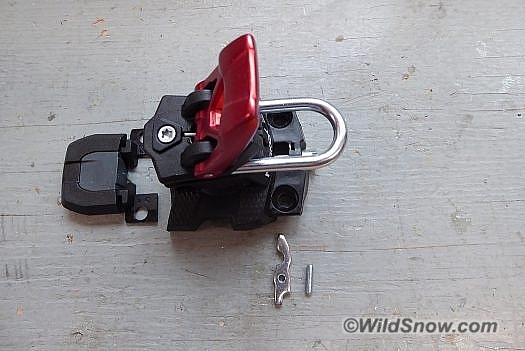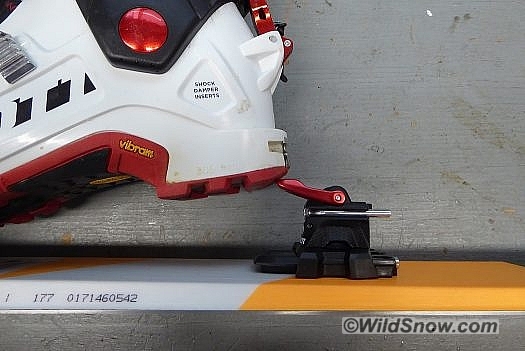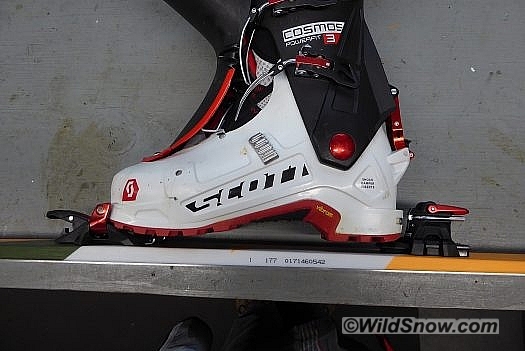Update: I did get out and ski the Alpinist. Nothing unusual. Noticed the minimal ramp while skiing, as well as the lower than normal heel climbing lift height. No particular problems, but this was not extensive use. Just a few months of summer and we’ll have them on snow again for extensive testing. Lou
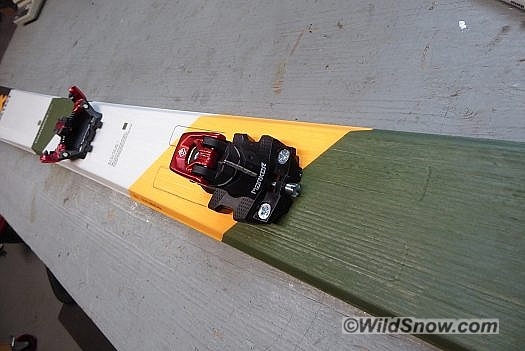
Marker Alpinist 12 (regular, not Long Travel) on a shiny new pair of Volkl VTA 98. Click images for clarity.
In a previous post, I alluded to the new Marker Alpinist ski touring binding being somewhat of a yawner. I might have been wrong, though we’ll need a season of testing to be certain. Sure, this is the “usual” U-spring binding, and I’d have preferred to see something more innovative from the big guys, but Marker’s weight is competitive (284 grams with screws for our “regular” version), and features such as above average toe jaw spring power and zero ramp could be highly attractive. My favorite checkmark so far? Other than the reasonable weight, I like the single damage-resistant T20 screw that adjusts lateral retention-release, though this might mean you’ll be carrying yet another bit in your repair kit. Least faves? Not much heel lifter height, and changing vertical tension does require a spring swap. Overall, very clean with state-of-art materials engineering. I’m also liking colors that don’t match those of an arcade merchandiser game.
Note, both flavors of Alpinist (12 and 9, alluding to max retention setting), will be available as “Long Travel” with 30 mm boot length adjustment and regular with 15 mm boot length adjustment. The binding we examine here is a 12 regular.
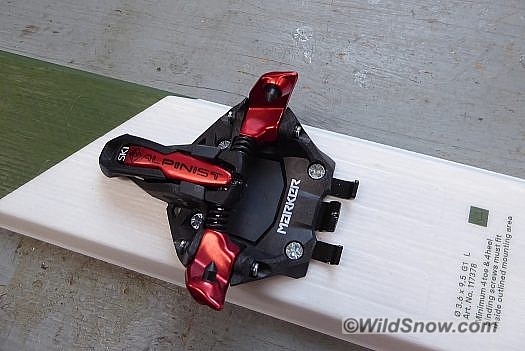
Toe unit is interesting in that the base chassis is carbon reinforced plastic, bold move. But let us meditate for the toe pins receiving the same attention, as Marker has indeed had problems in the past with weak pins.
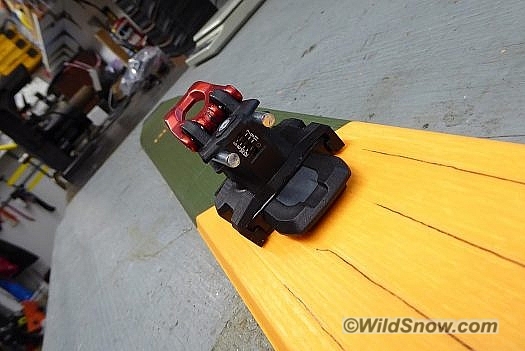
Heel is clean and simple, you can see the lateral retention settings scale, again note you swap springs to adjust vertical tension.
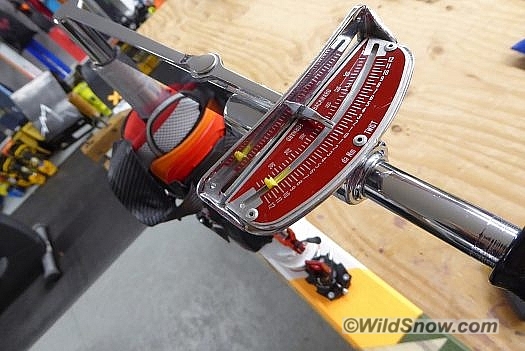
I was pleasantly surprised when my Vermont binding checker showed me the EXACT number I dialed on the printed binding scale (DIN standard allows significant variation). Other companies actually add the settings scale late in the manufacturing process, so it can be positioned for accurate calibration, perhaps that’s what Marker does. Incidentally, the spring they shipped pegged my checker scale in vertical mode, way too high for me. Two other springs are available, “Medium” and “Low.” Our test binding is a model “12” so it understandably defaults to the strongest spring. Lateral release scale ranges from 6 to 12.
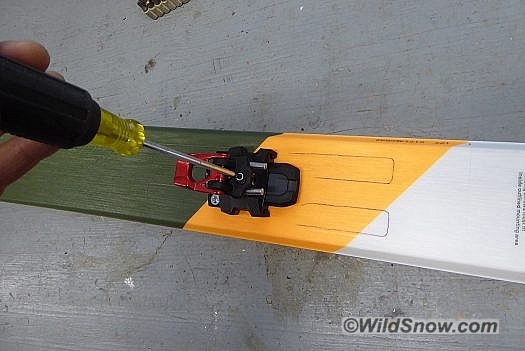
Adjusting retention with T20 driver, the boot length adjustment screw is pozi. Boot length range appears to be 15 mm.
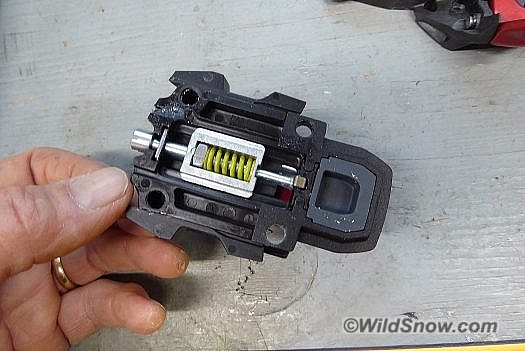
Underside of heel unit, ski flex compensation spring said to have 4 mm range. The binding is set for boot length with a ‘kiss’ gap (zero clearance but no pressure) between boot heel and binding.
Regarding bindings that require “kiss gap” between boot heel and rear binding housing: Know that when you step into the binding, if the ski is even slightly flexed (such as while standing in soft snow) your boot heel will encounter and possibly be blocked by the top of the binding housing before pressing down on the binding pins. Some binding brands with kiss gap have a “ramp” on the housing to help your boot slip down past the heel housing, down to the pins. The Alpinist appears to have an abrupt transition in this area, rather than a ramp. Jury is out on this until extensive real-world testing, but last winter a helpful reader pointed out this important design concept, so it’s on my informal list of “things to cover” when a new tech binding comes out. This factor can be significant with larger skiers in soft snow, as while they’re standing on their skis after entering binding toe, the heavily flexed ski places the top of the binding heel unit under their boot heel, and the boot will hit the top of the heel unit, sometimes by quite some distance. Note that most boots have various configurations of “lead in” ramps below the rear tech fitting to help with this, enhancing those with some judicious grinding can help.
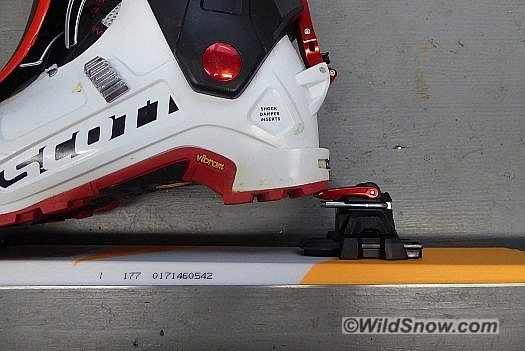
Medium lift is ok. Note that changing between medium and high lift requires rotating the binding heel
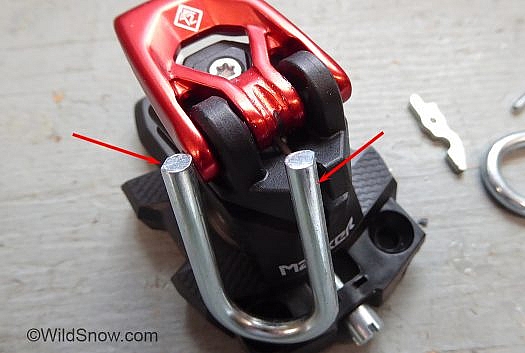
This is the “Medium” spring, with reduced stiffness due to flats on either side for a thinner profile, as indicated by arrows. Marker will spec this out being release value 9, mine measure as a 10 but bear in mind they’re pre-retail. In my experience, binding release check machines such as the Vermont Calibrator do well in measuring tech binding vertical release force (especially for comparisons between bindings and springs). Moreover an experienced binding user can guess at the number simply by how hard or easy the step in process occurs at the heel. Point being, no excuse to use potentially dangerous springs with excessively high release-retention settings. (Though on the other hand, it’s worth repeating that classic tech bindings have limited vertical elastic travel at the heel, so many skiers set tension at 1 or 2 steps above what works for them with rigs such as alpine bindings.
The numbers (know this is the “regular” version, with more boot length range at 15 mm, “Long Travel version has boot length range of 30mm and weighs slightly more):
– Toe weight with screws, 130 gr.
– Heel weight with screws, 154 gr.
– Total 284 gr.
– 0 ramp, negative 16 mm compared to classic Dynafit TLT, see our ramp-delta chart.
– Medium climbing lift is 11.7 mm above toe pins, high is 22 mm, we don’t mind the medium, but would prefer the high to be about twice as tall. Personally, I’d prefer more delta-ramp so I’ll probably shim up my heel units, that’ll give me a bit more climbing lift.
– Lateral release without heel is about RV 4 according to our Vermont calibrator and informal feel (this checks for possible minimum setting as well as toe spring “squeeze” force).
– Ski brakes: Long Travel will come with brakes at width of either 90, 105. Regular version will not come with brakes, but 90, 105 and 115 will be available under separate SKUs. In other words, if you wanted the Long Travel with 115 brake you’d have to buy the wider brake separate, while you’d also end up with the 90 or 105 brake the Long Travel came with. I know, I know… Marker has their reasons.
– Mounting screw patterns: Alpinist toe has same hole pattern as Marker Kingpin toe, 38 mm wide x 47 mm (pin line same, so direct swap is doable). Heel unit of Alpinist has same screw hole width as Kingpin, at 36 mm, but of course the pattern isn’t as long, Alpinist regular is 40 mm while Kingpin is 77 mm. The toe is direct swap for Kingpin, but heel will require at least another pair of holes, perhaps all four in some cases.
– Retail this fall.
WildSnow.com publisher emeritus and founder Lou (Louis Dawson) has a 50+ years career in climbing, backcountry skiing and ski mountaineering. He was the first person in history to ski down all 54 Colorado 14,000-foot peaks, has authored numerous books about about backcountry skiing, and has skied from the summit of Denali in Alaska, North America’s highest mountain.

